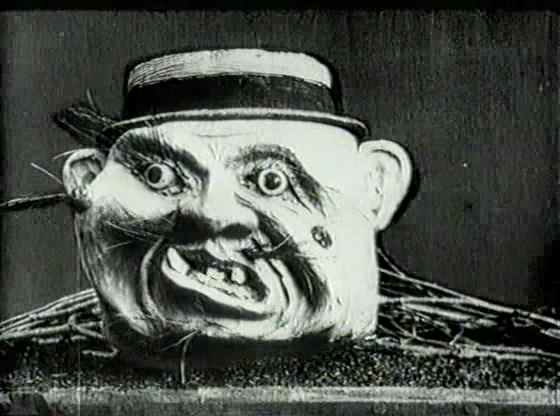
Segundo de Chomón (1871-1929) appears in film history, at first glance, as a George Méliès clone. A rather good one, admittedly—his shameless rip-off of A Trip to the Moon has more solid, three-dimensional sets, and a lot of beautiful gleaming: the cannon used to blast the lunarnauts into the firmament reflects the daylight with a splendid burnished glow. But the Spanish director was more than simply a gifted imitator: he was one of the most important cinema pioneers in history.
While still in his native Spain, working at Pathé, Teruel Segundo de Chomón y Ruiz first experimented in hand-tinting prints, then traveled to Paris and worked as filmmaker, actor and photographer. Much of his technical work involved developing new and more precise colour processes. In 1907 he invented the camera dolly.
1912 saw him in Italy, creating special effects for the epic Cabiria, a major influence on D.W. Griffith's Intolerance. It's likely that Chomon's influence accounts for the dolly shots in Cabiria—the Italians used the moving camera to emphasize the impressive sets they'd constructed. A whole tradition of Italian cinema, from Fellini to Bava to Bertolucci, has continued moving the camera to explore onscreen space, and the movie's amazing visuals led to Griffith building an elevator on a track to outdo the spectacle of the Italian traveling shots.
Throughout this period, Chomón was also writing, directing, photographing and producing films, from documentaries to Mélièsian fantasies, which went beyond mere imitation of the master, developing into full-blown celluloid fever dreams, delirious fits of lunacy that look forward to Buñuel, backwards to Bosch and sideways to the music hall. Une excursion incoherente (1909) is one of these.

Location: the front drive of a suburban villa, where an elborately bewhiskered Scotsman, played by the director, is boarding a carriage for a country trip with his wife and servants. The vehicle trundles out of frame, pedantically, and instantly finds itself in the studio, amid two-dimensional painted trees. Here, the trouble begins.
Like the discomfited diners of The Discrete Charm of the Bourgoisie, our unhappy campers soon find inexplicable problems with their victuals. Slicing into a sausage—by way of a very un-Meliesian interpolated close-up—the Celtic paterfamilias unleashes a storm of cockroaches. Hard-boiled eggs, when cracked, hatch live mice. Startled but undaunted, Chomón slices a cake in two, disgorging a payload of worms. Since worms can survive being cut in two, as every inquisitive schoolboy knows, perhaps this is the ideal hiding place for them.
A rainstorm, invisible to us (unless its represented by the vertical scratches lining the ancient print) but all too real to the holidaymakers, has everybody sheltering under a vast umbrella, but soon passes. Then it's off to the inn.
The bedroom. Chomón removes his greatcoat, unmasking a blinding array of tartanry. He seems quite recovered from the unpleasant outdoors repast. But downstairs, the servants are distressed by exploding pots, one of which grows a face, in the film's first use of stop-motion, and conceivably cinema's first use of claymation. The face has broom-bristle whiskers and eyeballs that dance clean out of their sockets, leaving distressing orifices to gape wetly at us. A chorus line of snaggly teeth dance to and fro in the rictus-frozen mouth, sixty years before Gilliam.
Another explosion produces a quartet of miniature maidens, bedecked in flowers, in the fireplace, but when the gibbering servants try to embrace them they magnesium-flare transform into a pair of shrouded morlocks. That's what you get. Struggling with these phantasms, the servants end up fighting each other, nothing left of their assailants save a sheet.
Meanwhile, Chomón's wife turns in for the night, a sheet hung up to screen her from her husband, in best It Happened One Night fashion. Upon this wall of Jericho is projected a silhouette shadowshow, switching halfway through into cut-out animation, in which, for no readily understandable reason, a little railway bridge constructs itself over the slumbering woman, and a snake-sized locomotive passes over her body and then into her mouth. A birdcage assembles itself on her chest, a bird appears within it, then leaves and follows the steam train down madame's gullet. This in some way causes a house to be built in place of her head. A miniature woman appears on the balcony, a diminutive man appears in the garden, their heads detach briefly and kiss.
The house vanishes, but the respite is brief, for now a foot is sprouting from the woman's mouth. An entire disembodied leg emerges, then grows itself a body: Satan himself! Or one of his imps: a second daemon appears at madame's feet and maliciously pours a jug of water onto her knees.

Chomón wakes up screaming—this has apparently been his dream, not hers. Fleeing outside, he finds a dragon on the roof: a quarter-sized ancestor of the one in Lang's Siegfried. A rubber snake is fed out of the drinking well, unspooling on the ground like a film strip. The dragon breathes fire and Chomón clutches his brow in the throes of some agonizing paroxysm. He collapses to the ground, which is the cue for a vile grinning Humpty Dumpty head to replace the well, rising into the air on a striped and limbless extending body, one eye flicking left and right in idiot spasm. Recovering his faculties, Chomón besieges the monstrosity with a pitchfork, but it vanishes.

Bedroom farce: the entire humanoid cast run around, entering the inn through one door and exiting from another, with variations. Nobody is chasing them—or at least, nobody we can see. Everybody falls down the well, but the last one in drags the others out. Chomón, when eventually restored to the surface world, is bloated and waterlogged, his stomach a balloon. Artificial resuscitation makes water spout from his lips. The End.
Total running time: eight minutes fourteen seconds.
***
The Forgotten is a regular Thursday column by David Cairns, author of Shadowplay.